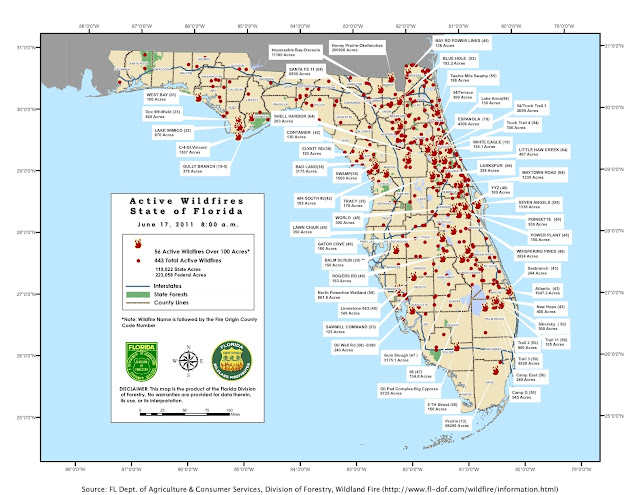For much of April into late May, it has been a tad wet here in NJ. We had a few days of drier weather in early May was followed by at least a week of daily rain events (through May 23). I may be mistaken, but as I recall, there have been no red flag warnings or enhanced fire weather advisories for any portion of NJ since late March or early April.
While some areas of NJ have had isolated showers or thunderstorms over the last seven to ten days or so, we have begun to dry out so to speak.
In my little corner of NJ, we had a thunderstorm early Sunday morning followed by a shower yesterday. I figured that at some point the conditions would again be favorable for fires, and the weather service would issue either an enhanced fire weather advisory or a red flag warning.
No red flag warnings, but I did note the following enhanced fire advisory in the hazardous weather outlook issued by the
Mt. Holly Office of the National Weather Service at 3:28 AM EDT this morning:
THIS HAZARDOUS WEATHER OUTLOOK IS FOR CENTRAL DELAWARE...NORTHERN
DELAWARE...SOUTHERN DELAWARE...NORTHEAST MARYLAND...CENTRAL NEW
JERSEY...NORTHERN NEW JERSEY...NORTHWEST NEW JERSEY...SOUTHERN NEW
JERSEY...EAST CENTRAL PENNSYLVANIA...NORTHEAST PENNSYLVANIA AND
SOUTHEAST PENNSYLVANIA.
.DAY ONE...TODAY AND TONIGHT.
ENHANCED FIRE WEATHER CONDITIONS WILL OCCUR TODAY...WITH GUSTY
NORTHWEST WINDS...LOWERING HUMIDITIES...AND DRYING FINE FUELS.
followed by the special weather statement at 8:06 AM:
SPECIAL WEATHER STATEMENT
NATIONAL WEATHER SERVICE MOUNT HOLLY NJ
806 AM EDT THU JUN 2 2011
DEZ001>004-MDZ008-012-015-019-020-NJZ001-007>010-012>027-PAZ054-
055-060>062-067>071-022300-
NEW CASTLE-KENT-INLAND SUSSEX-DELAWARE BEACHES-CECIL-KENT MD-
QUEEN ANNES-TALBOT-CAROLINE-SUSSEX-WARREN-MORRIS-HUNTERDON-
SOMERSET-MIDDLESEX-WESTERN MONMOUTH-EASTERN MONMOUTH-MERCER-SALEM-
GLOUCESTER-CAMDEN-NORTHWESTERN BURLINGTON-OCEAN-CUMBERLAND-
ATLANTIC-CAPE MAY-ATLANTIC COASTAL CAPE MAY-COASTAL ATLANTIC-
COASTAL OCEAN-SOUTHEASTERN BURLINGTON-CARBON-MONROE-BERKS-LEHIGH-
NORTHAMPTON-CHESTER-MONTGOMERY-BUCKS-DELAWARE-PHILADELPHIA-
INCLUDING THE CITIES OF...WILMINGTON...DOVER...GEORGETOWN...
REHOBOTH BEACH...ELKTON...CHESTERTOWN...CENTREVILLE...EASTON...
DENTON...NEWTON...WASHINGTON...MORRISTOWN...FLEMINGTON...
SOMERVILLE...NEW BRUNSWICK...FREEHOLD...SANDY HOOK...TRENTON...
PENNSVILLE...GLASSBORO...CAMDEN...CHERRY HILL...MOORESTOWN...
MOUNT HOLLY...JACKSON...MILLVILLE...HAMMONTON...
CAPE MAY COURT HOUSE...OCEAN CITY...ATLANTIC CITY...
LONG BEACH ISLAND...WHARTON STATE FOREST...JIM THORPE...
STROUDSBURG...READING...ALLENTOWN...BETHLEHEM...WEST CHESTER...
NORRISTOWN...DOYLESTOWN...MEDIA...PHILADELPHIA
806 AM EDT THU JUN 2 2011
...ENHANCED FIRE WEATHER CONCERNS...
A DRIER AND GUSTY WEST TO NORTHWEST WINDS WILL INCREASE OVER THE
AREA THIS MORNING AND PERSIST INTO THE AFTERNOON. RELATIVE
HUMIDITY LEVELS AND FUEL MOISTURE LEVELS WILL DECREASE THROUGH THE
DAY ALSO. THESE CONDITIONS INCREASE CONCERNS FOR WILDFIRE GROWTH
ACROSS THE AREA TODAY. CONSIDER POSTPONING ANY ACTIVITY THAT
INVOLVES OUTSIDE BURNING TODAY.
Don't know what will happen today. If I hear of anything in the way of wildfires here in NJ, which I may or may not depending, I'll follow-up here.















